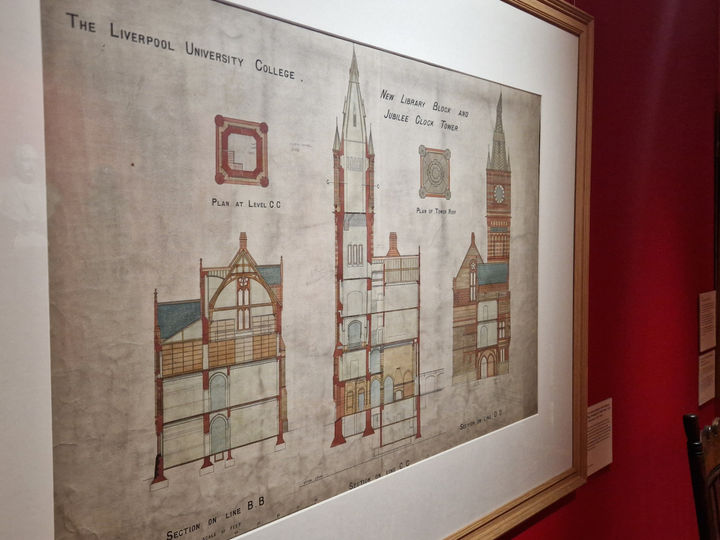
Chapter One:
THE ARCHITECT
Title: Chapter One: The Architect.
Overview: The life of Liverpudlian, Alfred Waterhouse, and his other significant projects in the Liverpool City Region.
Biography
Alfred Waterhouse is recognised nationally as one of the most prolific and financially successful Victorian Architects, often known for his elaborate and expansive High Victorian buildings. Unparalleled in scale and intricacy, with his range of extensive works being enjoyed across the United Kingdom, there is a reason why he is practically a household name in the architectural realm.
As previously mentioned, his High Victorian Gothic Revival style was an eclectic architectural style combining a wide variety of materials
Born in 1830 in Anfield in the City of Liverpool, to a Quaker Family, Alfred Waterhouse Senior and Mary Waterhouse. Shortly after Alfred's birth, his family moved to Aigburth in the Southern part of the City.
One of Waterhouse's most notable contemporaries was George Gilbert Scott, with both renown for their love of Gothic Revival. Interestingly, both families had a multigenerational lineage of architects. The notable architects in the Gilbert Scott Family includes: George Gilbert Scott (1811–1878; aged 66) having George Gilbert Scott Junior (1839–1897; aged 58), in turn Giles Gilbert Scott (1880–1960; aged 79), and then Richard Gilbert Scott (1923–2017; aged 83).
The notable architects in the Waterhouse Family includes: Alfred Waterhouse (1830–1905; aged 75), his son Paul Waterhouse (1861–1925; aged 63), and Michael Waterhouse (1888–1968; aged 79).
Waterhouse had the opportunity to train as an architect in Manchester, under the tutelage of Richard Lane as part of an apprenticeship.
He went on to become one of the most financially successful architects of the Victorian Era.
Image Credit: Alfred Waterhouse (1830—1905). By Ralph Winwood Robinson, published by C. Whittingham & Co platinum print, c.1889. Courtesy of The National Portrait Gallery.

Interactive Ordnance Survey Map:
Alfred Waterhouse's Lifetime In Comparison To Present Day
Fascinating Facts About Alfred Waterhouse & His Work
01.
Architectural Style
Alfred was acclaimed for his High Victorian Gothic Revival architecture.
02.
The Red Brick
In one of Alfred's signature styles: Common brick with red brick and terracotta dressings over a fire-proof iron frame. (University of Liverpool, 2018).
04.
When Did Alfred Start To Design The Building?
Alfred Waterhouse started to design the building in 1887 after funding was raised to start construction for the then proposed University College Liverpool Building.
03.
Why Is It Named Victoria?
The Victoria Building gained its name to coincide with the Golden Jubilee of Queen Victoria in 1887 which was when Alfred started to design the building.
05.
Father & Son
Alfred Waterhouse lived to the age of 75 years old (1830–1905) and was named after his Father, Alfred Waterhouse, who also lived to the age of 75 years old (1798–1873).
Photography Gallery: Architectural Sketches Of Victoria Building By Alfred Waterhouse


Relatives Of Alfred Waterhouse


Timeline Of Alfred Waterhouse
-
19th of July 1830 — He was born in Aigburth in South Liverpool, UK.
-
1859 — Won the open competition for the design of the Manchester Assize Courts.
-
1860 — Married Elizabeth Hodgkin, a fellow Quaker.
-
1861 — The birth of his son, Paul Waterhouse, on the 29th of October in Fallowfield.
-
1863 — Birth of his daughter, Mary Monica Waterhouse, on the 31st of August in Fallowfield.
-
1865 — He opened an office in London.
-
1865 — Designed Hutton Hall, Guisborough.
-
1866 — Birth of his daughter, Florence Eliot Waterhouse, on the 11th of November in London.
-
1868 — Birth of his son, Alfred Maurine Waterhouse, on the 19th of April in London. He sadly passed away before the age of 12.
-
1868 — Won the competition for the design of Manchester Town Hall.
-
1868 — Began rebuilding Gonville and Caius College, Cambridge.
-
1867-69 — Designed new buildings at Balliol College, Oxford.
-
1871 — Designed Pembroke College, Cambridge.
-
1871 — North Western Hotel, Liverpool Lime Street opened.
-
1872 — Birth of son Amyas Theodore Waterhouse (19th November, Marylebone London).
-
1873 — Building of Girton College, University of Cambridge, which was started and completed by three generations of The Waterhouse Family.
-
1873-81 — Designed Natural History Museum, London.
-
1887 — Designed the University of Liverpool's iconic red brick Victoria Building.
-
1883 — designed Lyndhurst Congregational Church in Camden, London.
-
1887 — He converted to Anglicanism.
-
1890 — Hotel Metropole, Brighton, was completed.
-
1889-1891 — Kings Weigh House Chapel in London was built.
-
1891 — He brought his eldest son, Paul Waterhouse, into his practice.
-
1892 — The University of Liverpool's Victoria Building was completed.
-
1896 — Designed new University College Hospital, Bloomsbury, London. It was completed in 1906.
-
1905 — Alfred Waterhouse died, in Yattendon, Berkshire in England at the age of 75.
Born:
1830
Died:
1905
Further Reading
-
Fisher, K., (2022) 130 years of the Victoria building. [online] University of Liverpool. Available at: https://vgm.liverpool.ac.uk/blog/2022/130-years-of-the-victoria-building/ [Accessed 02 Apr. 2024].
-
Historic England, (n.d.) Victoria building, Liverpool University, Liverpool. [online] historicengland.org.uk. Available at: https://historicengland.org.uk/services-skills/education/educational-images/victoria-building-liverpool-university-liverpool-4704 [Accessed 03 Apr. 2024].
-
University of Liverpool, (2018) University of Liverpool: The University Estate strategy 2026+ - Campus Built Heritage. [online] Liverpool.ac.uk. Available at: https://www.liverpool.ac.uk/media/livacuk/University,of,Liverpool_Campus,Built,Heritage.pdf [Accessed 03 Apr. 2024].
-
University of Liverpool, (n.d.) History of the Victoria building - Victoria gallery & museum. [online] University of Liverpool. Available at: https://vgm.liverpool.ac.uk/about-us/building-history/ [Accessed 02 Apr. 2024].

.png)












